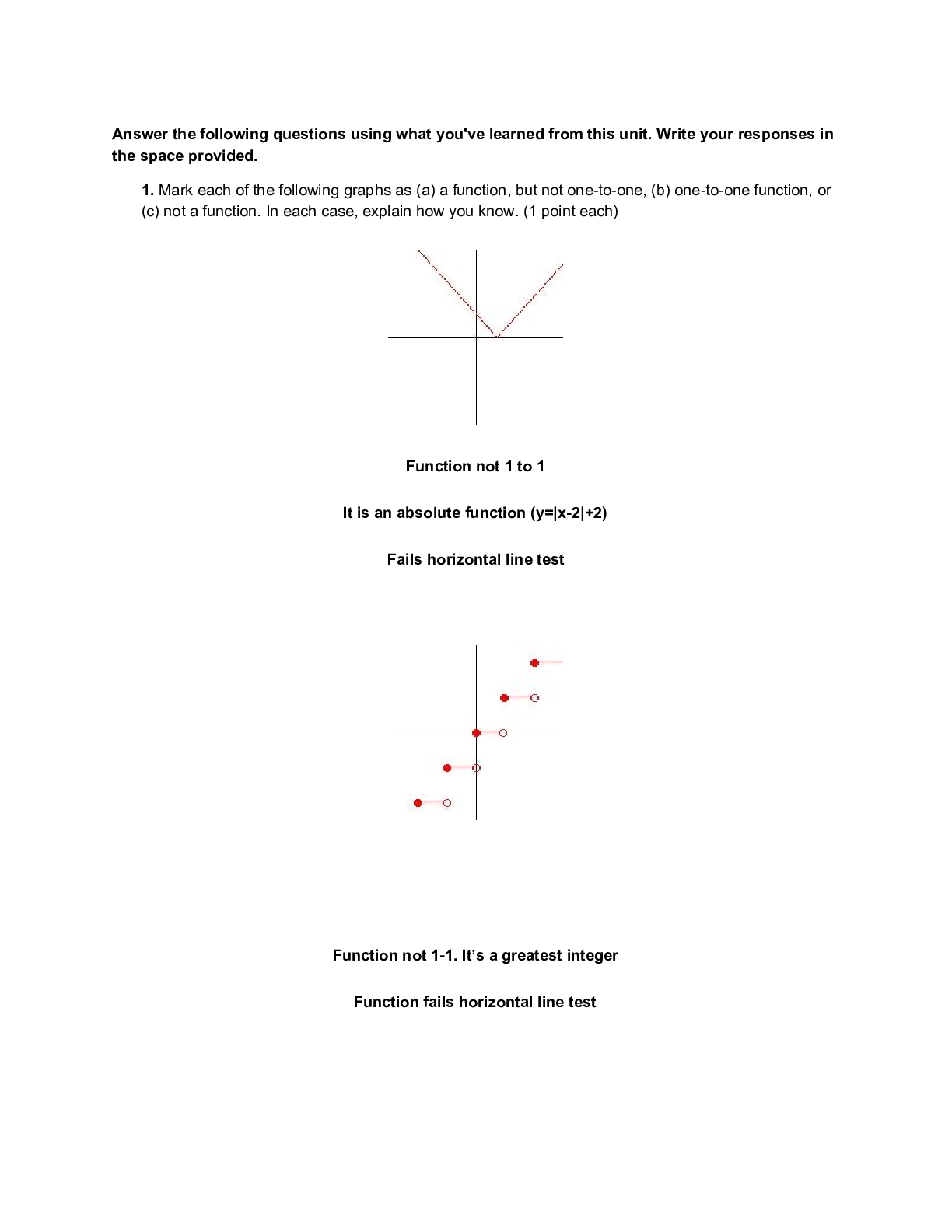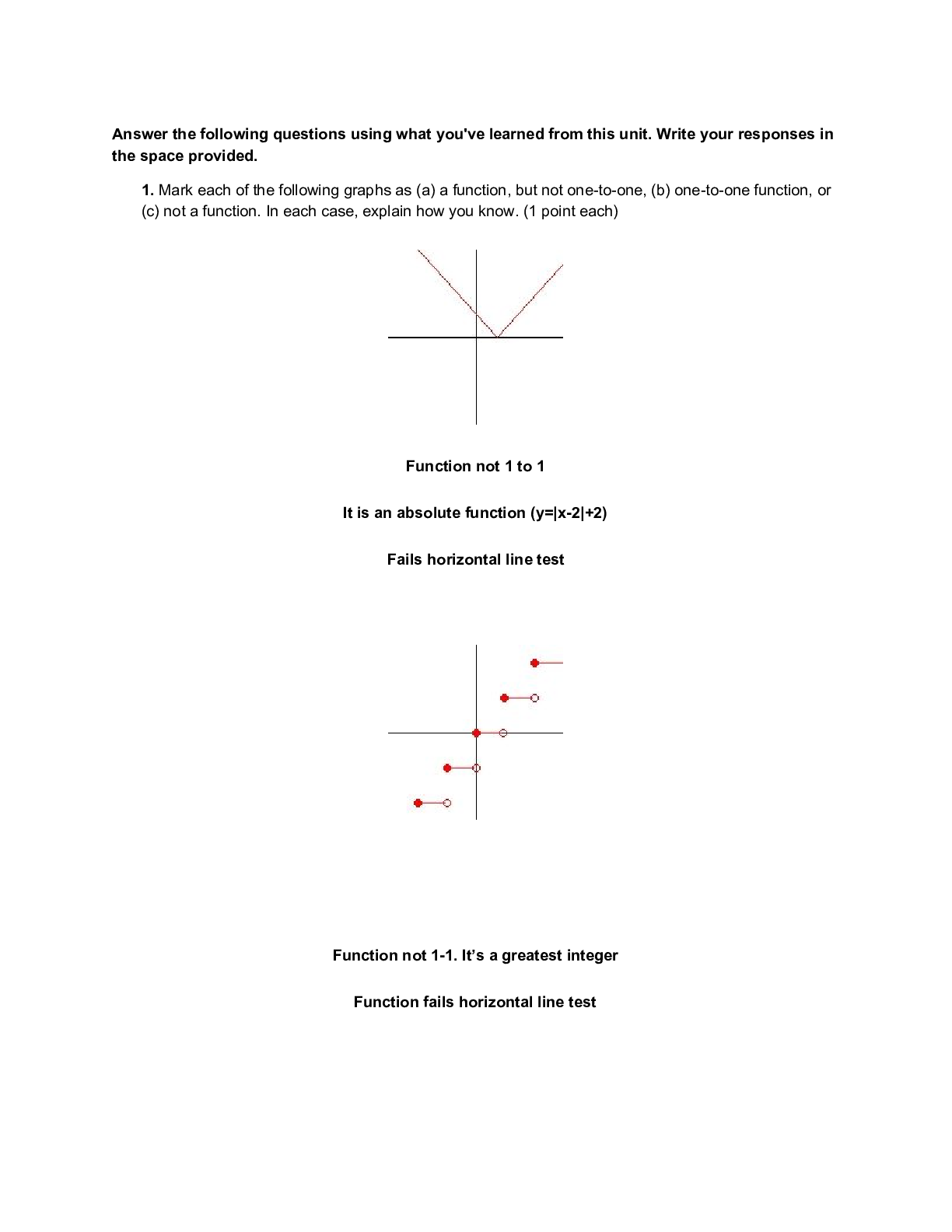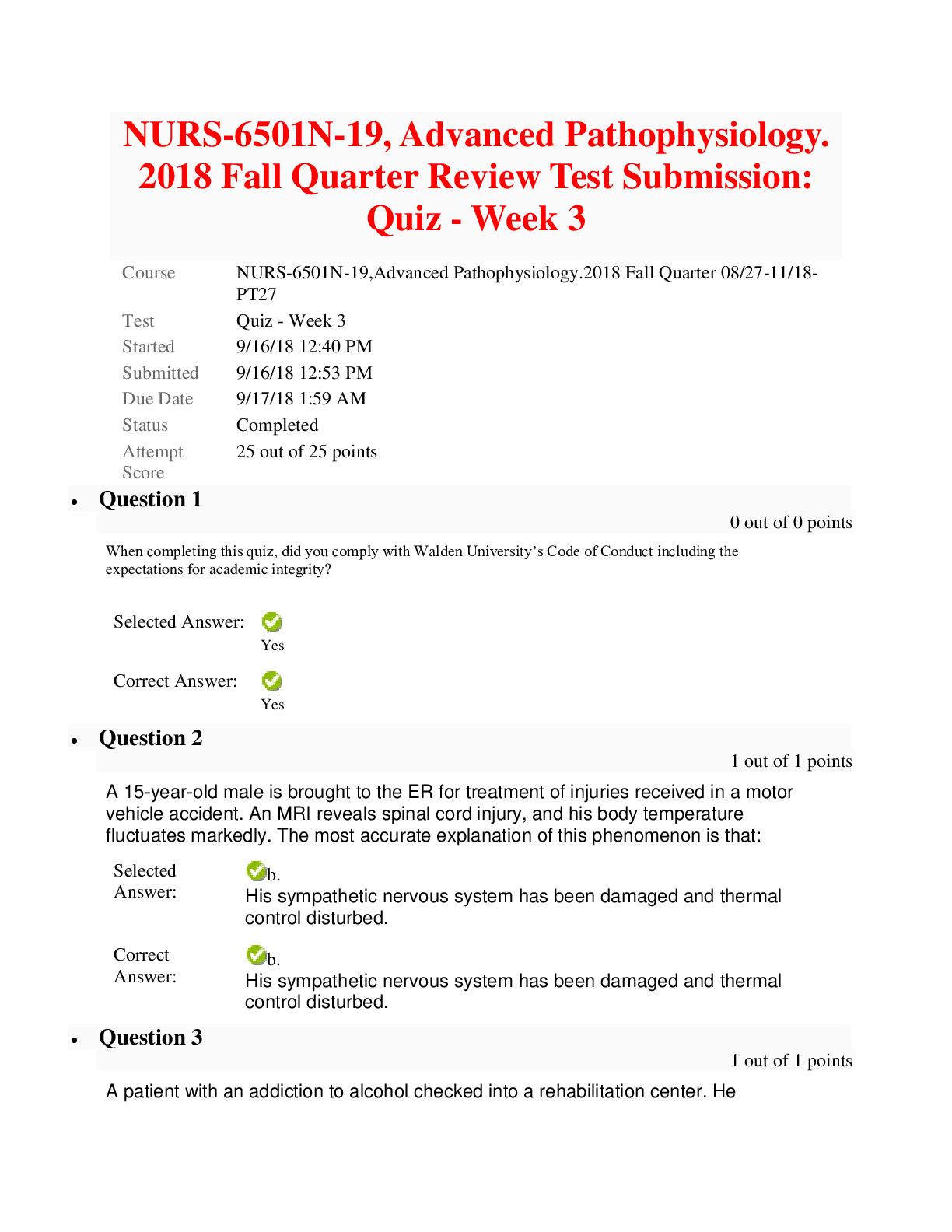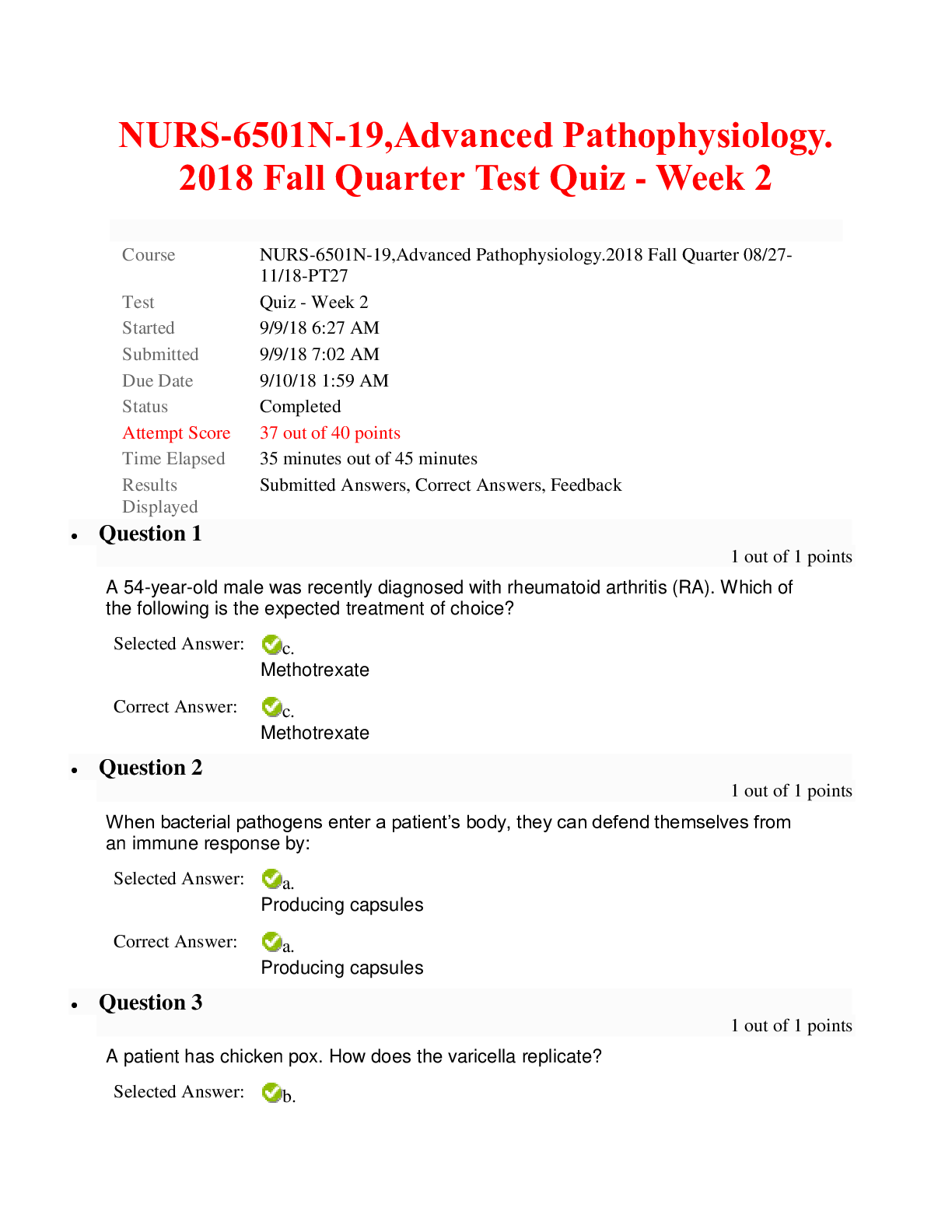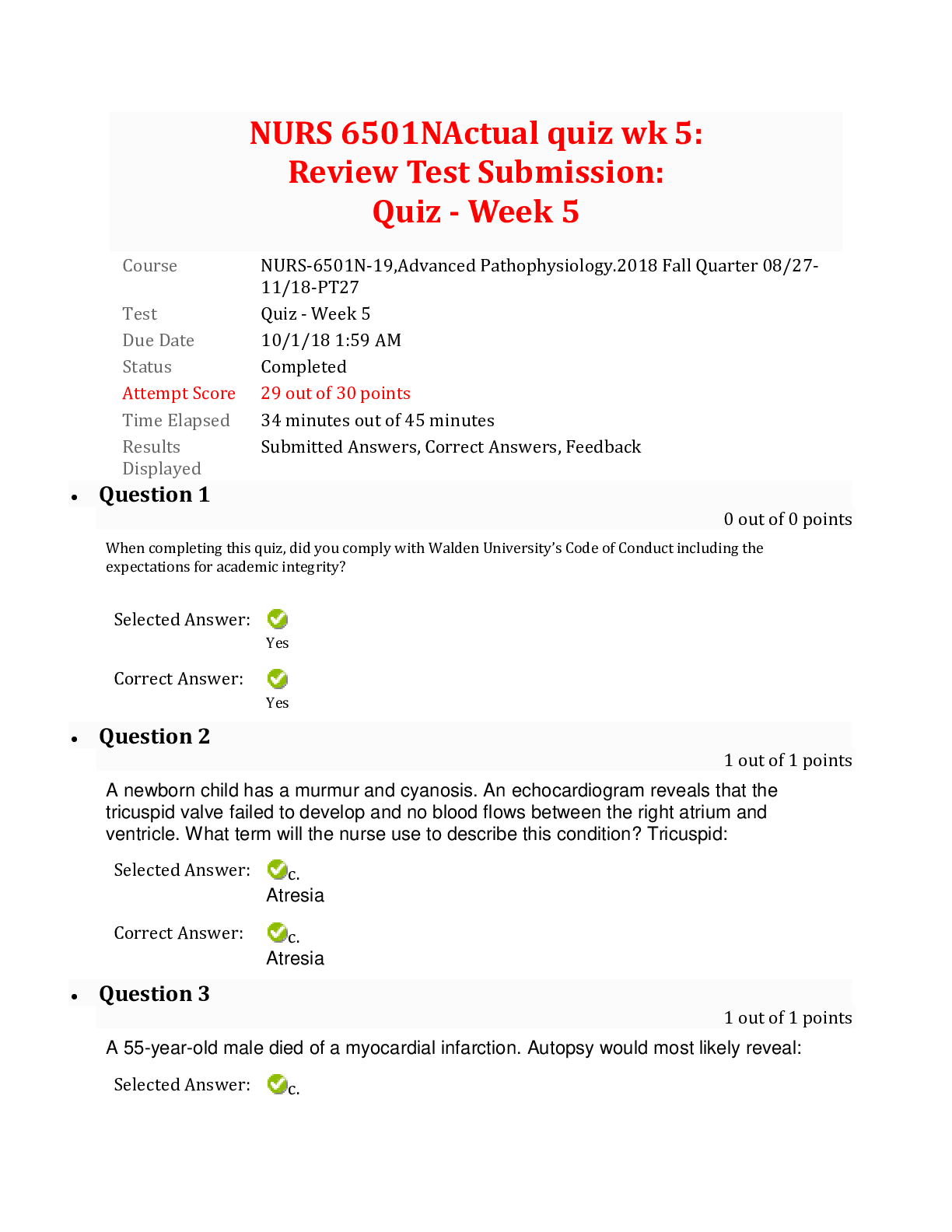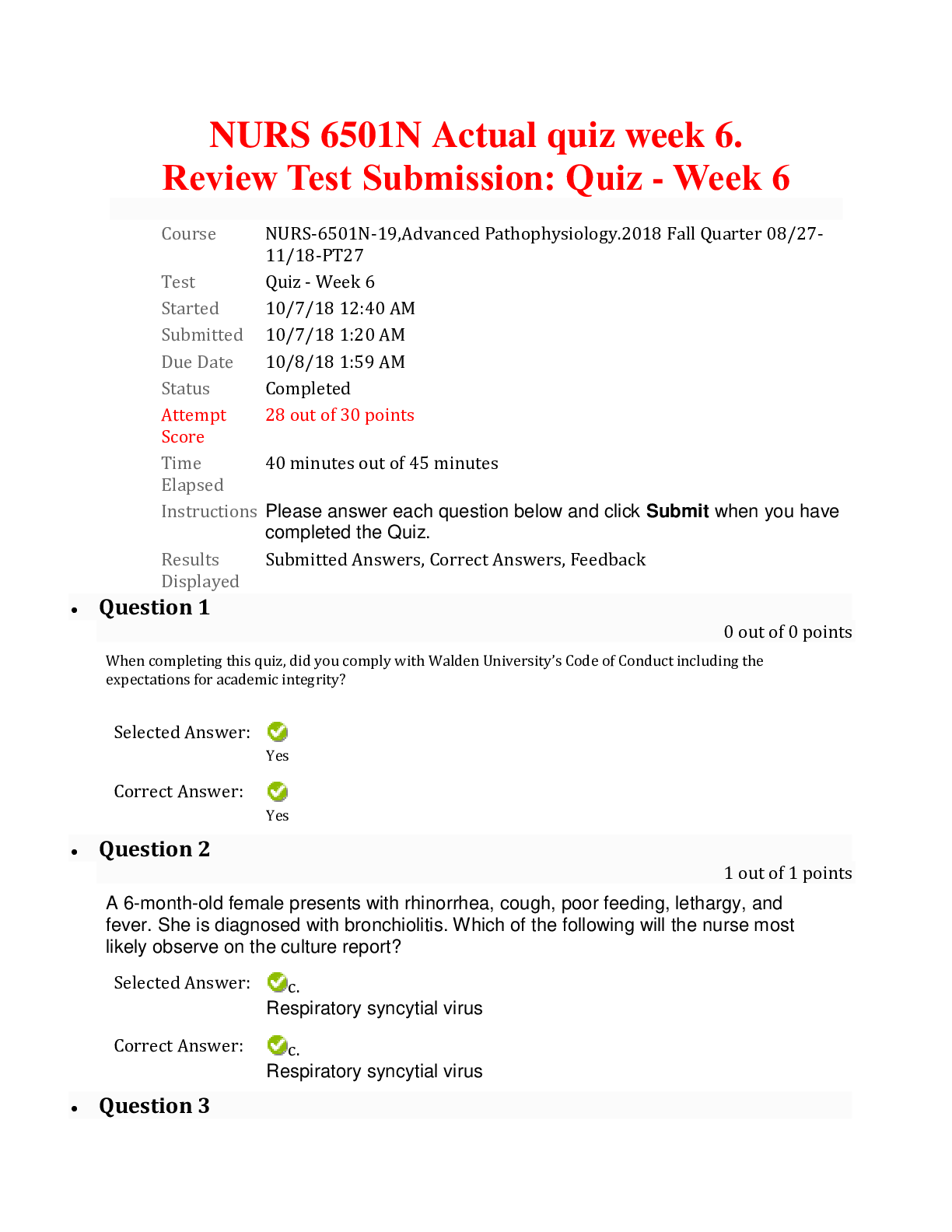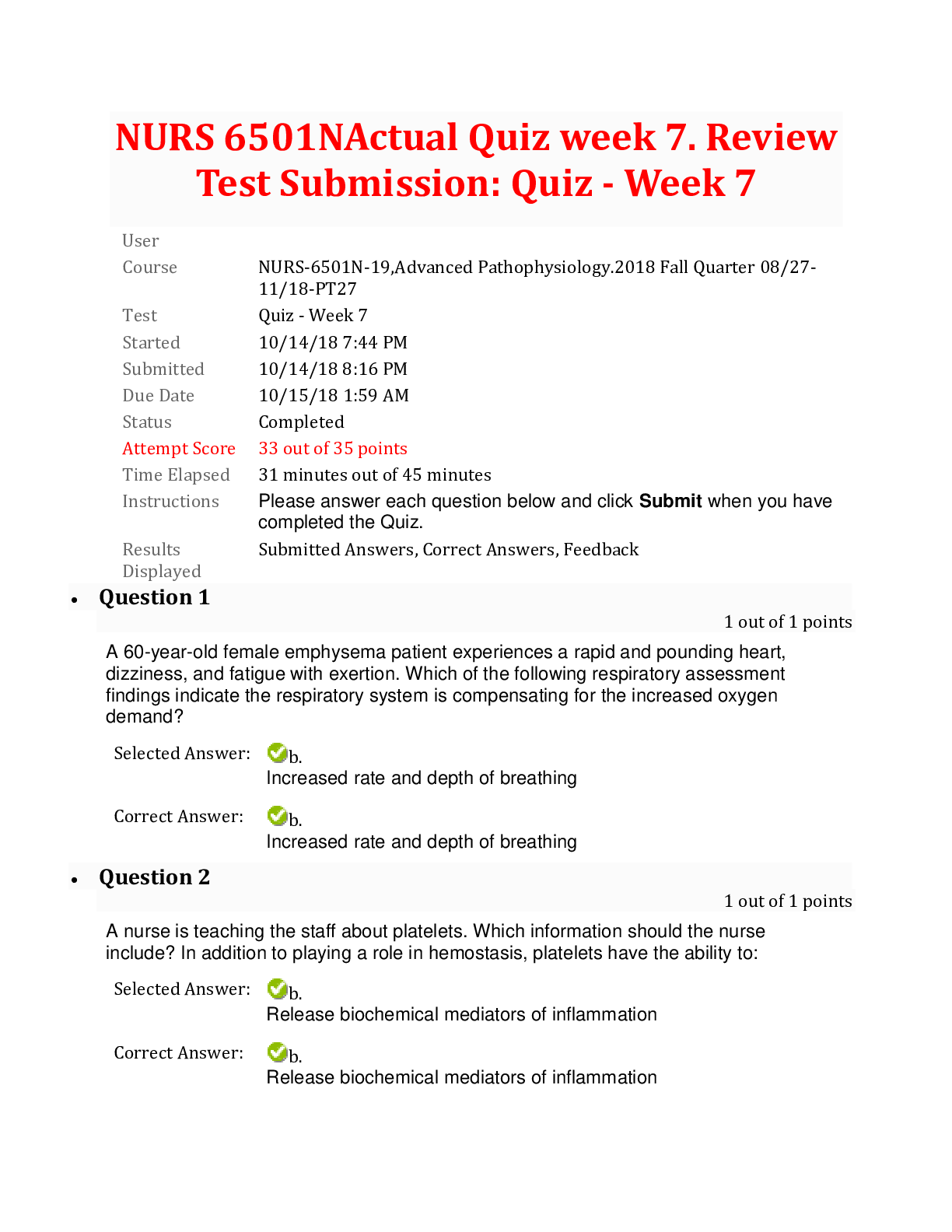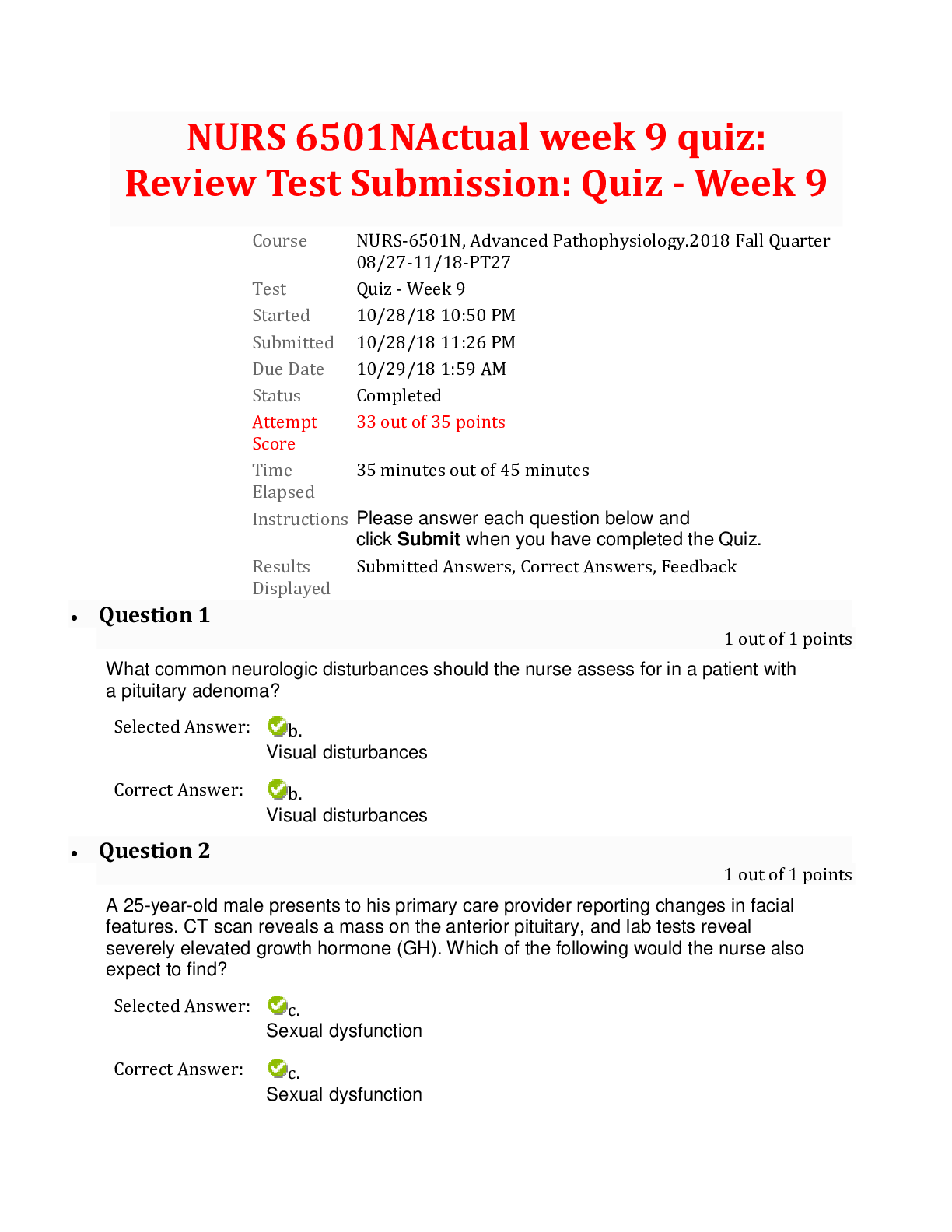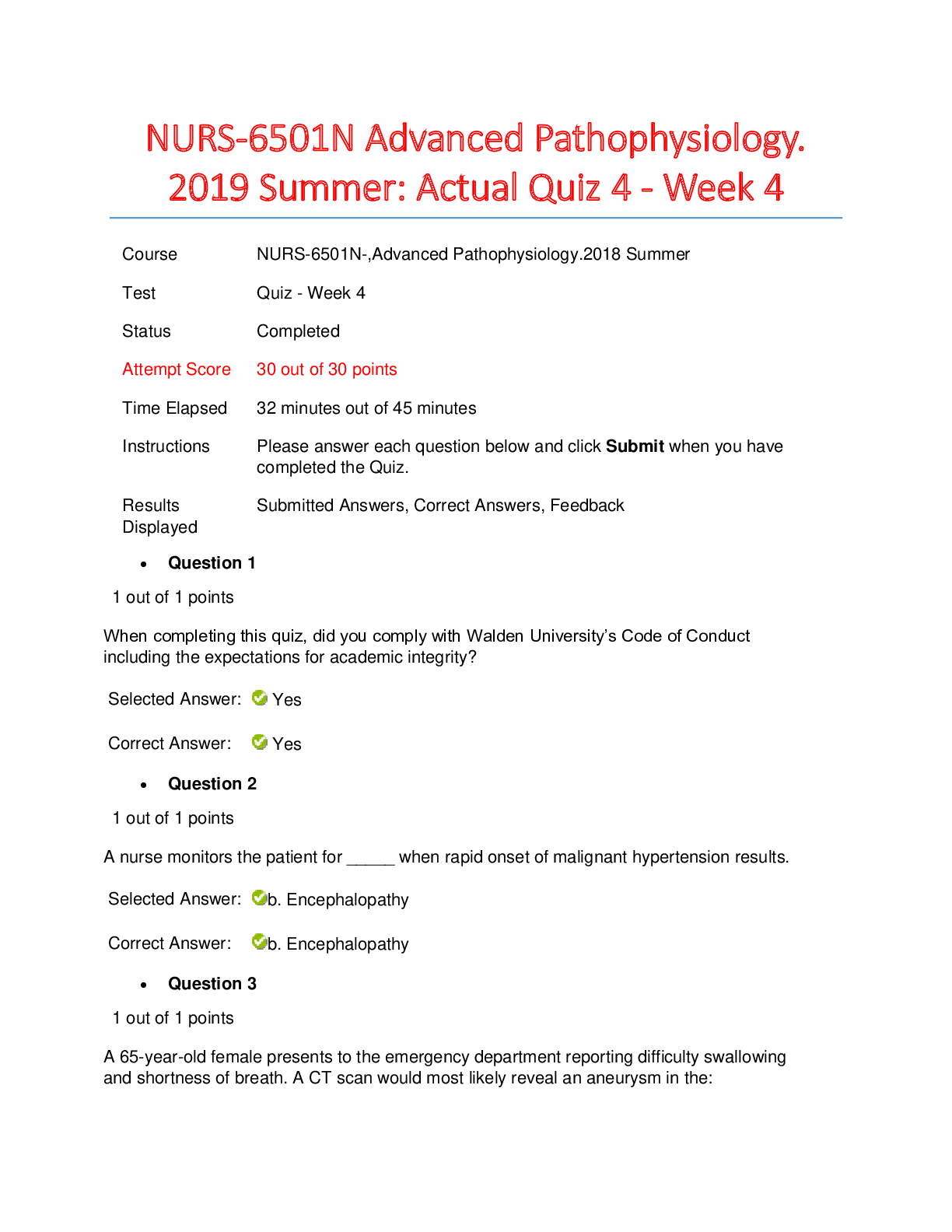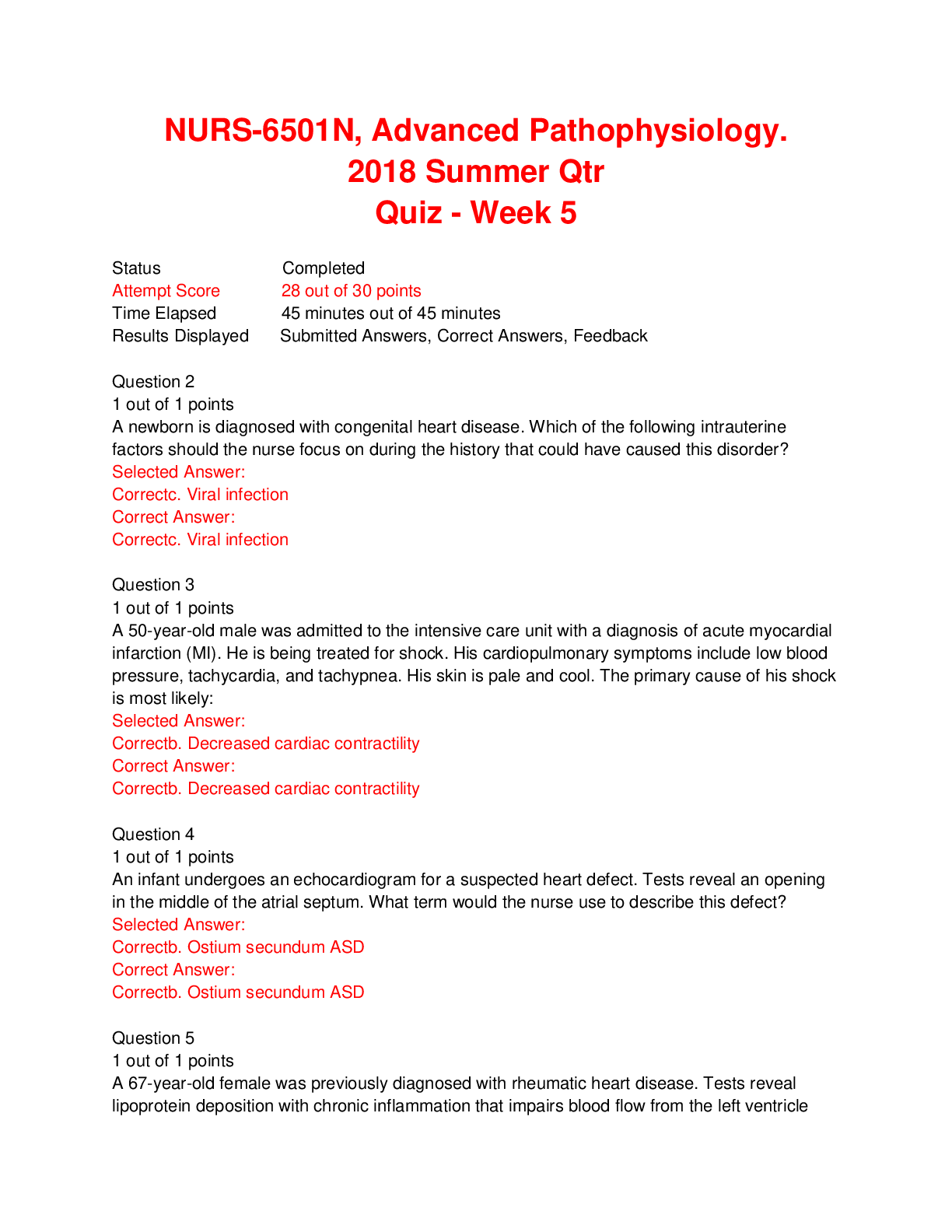*NURSING > QUESTIONS & ANSWERS > NURS-6501N-19, Advanced Pathophysiology. 2018 Fall Quarter Review Test Submission: Actual Quiz 10 - (All)
NURS-6501N-19, Advanced Pathophysiology. 2018 Fall Quarter Review Test Submission: Actual Quiz 10 - Week 10 (Walden University). 100% Correct Answers.
Document Content and Description Below
NURS 6501NActual Week 10 quiz: Review Test Submission: Quiz - Week 10 Course NURS-6501N-19, Advanced Pathophysiology.2018 Fall Quarter 08/27-11/18-PT27 Test Quiz - Week 10 Instructions Please... answer each question below and click Submit when you have completed the Quiz. Results Displayed Submitted Answers, Correct Answers, Feedback • Question 1 1 out of 1 points A 42-year-old female is diagnosed with chronic renal failure, and the nurse is discussing dietary treatment. Which information indicates the nurse understands dietary regimen? Treatment includes restricting: • Question 2 1 out of 1 points A 30-year-old male is demonstrating hematuria with red blood cell casts and proteinuria exceeding 3 to 5 g/day, with albumin being the major protein. The most probable diagnosis the nurse will see documented on the chart is: • Question 3 1 out of 1 points A nurse is reviewing urinalysis results and notices glucose is present in the urine. A nurse realizes glucose will be excreted in the urine when: • Question 4 1 out of 1 points A 15-year-old male was diagnosed with pharyngitis. Eight days later he developed acute glomerulonephritis. While reviewing the culture results, which of the following is the most likely cause of this disease? • Question 5 1 out of 1 points A nurse is preparing to teach about the loop of Henle. Which information should be included? The descending segment of the loop of Henle primarily allows for: • Question 6 1 out of 1 points A 55-year-old male presents reporting urinary retention. Tests reveal that he has a lower urinary tract obstruction. Which of the following is of most concern to the nurse? • Question 7 1 out of 1 points When a patient’s renal system secretes rennin, what effect will that cause in the body? It causes the direct activation of: • Question 8 1 out of 1 points Which of the following clusters of symptoms would make a clinician suspect a child has developed glomerulonephritis? • Question 9 1 out of 1 points When the nurse discusses the glomerulus and Bowman capsule together, it is referred to as the renal: • Question 10 1 out of 1 points A 6-year-old male is experiencing urine reflux from the urinary bladder into a grossly dilated ureter and calyces. He was diagnosed with vesicoureteral reflux. This condition would be graded: • Question 11 1 out of 1 points When a child is admitted with acute renal failure, a clinician realizes the most common cause of acute renal failure is: • Question 12 1 out of 1 points A 60-year-old male is diagnosed with renal failure. While the nurse is reviewing lab results, which of the following lab values would be most consistent with this diagnosis? • Question 13 1 out of 1 points On average the kidneys receive approximately _____ of the cardiac output. • Question 14 1 out of 1 points A 45-year-old female presents with hypertension, anorexia, nausea and vomiting, and anemia. She is diagnosed with chronic renal failure. When the patient asks what caused this anemia, how should the nurse respond? Your anemia is caused by: • Question 15 1 out of 1 points A 25-year-old female presents with burning urination. She was diagnosed with a urinary tract infection. When the nurse checks the culture results, which of the following organisms is most likely infecting her urinary tract? • Question 16 1 out of 1 points When a nurse is preparing to teach about urine, which information should the nurse include? Just before entering the ureter, urine passes through the: • Question 17 1 out of 1 points A 19-year-old female was involved in a motor vehicle accident during which she sustained a closed head injury. She is now experiencing detrusor sphincter dyssynergia. Which of the following is the most beneficial medication treatment? • Question 18 1 out of 1 points While planning care for a patient who has acute pyelonephritis. A nurse recalls the most common condition associated with the development of acute pyelonephritis is: • Question 19 1 out of 1 points Anemia accompanies chronic renal failure because of: • Question 20 1 out of 1 points When a nurse is checking the urinalysis, plasma proteins should be absent from the urine because: • Question 21 1 out of 1 points A 30-year-old male is demonstrating hematuria with red blood cell casts and proteinuria exceeding 3 to 5 g/day, with albumin being the major protein. The most probable diagnosis the nurse will see documented on the chart is: • Question 22 1 out of 1 points A 3-year-old female presents with recurrent urinary tract infections (UTIs), fever, poor growth and development, and feeding problems. Tests reveal a retrograde flow of urine from the urinary bladder into the ureters. When giving report to the oncoming shift, the nurse will call this condition: • Question 23 1 out of 1 points When the nurse is discussing the sodium-sensing cells of the glomerulus, what term should the nurse use? • Question 24 1 out of 1 points While planning care for a patient with renal calculi, the nurse remembers the most important factor in renal calculus formation is: • Question 25 1 out of 1 points A 35-year-old hypertensive male begins taking a diuretic. Which of the following common side effects of this medication should the nurse monitor? • Question 26 1 out of 1 points A 75-year-old male reports to his primary care provider loss of urine with cough, sneezing, or laughing. Which of the following is the most likely diagnosis the nurse will observe on the chart? • Question 27 1 out of 1 points A 15-year-old female presents with flank pain, irritability, malaise, and fever. Tests reveal glomerulonephritis. When the parents ask what could have caused this, how should the nurse respond? • Question 28 1 out of 1 points A 24-year-old female is diagnosed with renal calculus that is causing obstruction. Which of the following symptoms would she most likely experience? • Question 29 0 out of 1 points A 27-year-old male has a severe kidney obstruction leading to removal of the affected kidney. Which of the following would the nurse expect to occur? • Question 30 1 out of 1 points A 7-year-old male presents to his primary care provider for incontinence. His mother indicates that he has never been continent. Which of the following is the most likely diagnosis the nurse will observe on the chart? • Question 31 1 out of 1 points A nurse is describing the trigone. Which information should be included? The trigone is defined as: • Question 32 1 out of 1 points A 35-year-old female was severely burned and is hospitalized. She is now suffering from acute tubular necrosis (ATN). Which of the following is the most likely diagnosis the nurse will observe on the chart? • Question 33 1 out of 1 points While turning a patient with chronic renal failure, which principle should the nurse recall? Bone fractures are a risk factor in chronic renal failure because: • Question 34 1 out of 1 points A 2-year-old male is diagnosed with Wilms tumor. Which of the following clinical conditions is often associated with this disease? • Question 35 1 out of 1 points A urologist is discussing the phagocytic cells that lie between the layers of the renal corpuscle. What is the urologist describing? • Question 36 1 out of 1 points If a nurse wants to obtain the best estimate of renal function, which test should the nurse monitor? • Question 37 1 out of 1 points A 25-year-old female is diagnosed with urinary tract obstruction. While planning care, the nurse realizes that the patient is expected to have hydronephrosis and a decreased glomerular filtration rate caused by: • Question 38 1 out of 1 points A 56-year-old male presents with flank pain and polyuria. Tests reveal that he has an enlarged prostate. Which of the following types of renal failure should the nurse monitor for as it is the most likely to occur? • Question 39 1 out of 1 points A 29-year-old female presents with cloudy urine, flank pain, hematuria, and fever. Which of the following does the nurse suspect the patient is most likely experiencing? • Question 40 1 out of 1 points A 5-year-old male was diagnosed with glomerulonephritis. History reveals that he had an infection 3 weeks before the onset of this condition. The infection was most likely located in the: • Question 41 0 out of 0 points When completing this quiz, did you comply with Walden University’s Code of Conduct including the expectations for academic integrity? [Show More]
Last updated: 1 year ago
Preview 1 out of 11 pages
Instant download

Buy this document to get the full access instantly
Instant Download Access after purchase
Add to cartInstant download
Reviews( 0 )
Document information
Connected school, study & course
About the document
Uploaded On
Jul 18, 2020
Number of pages
11
Written in
Additional information
This document has been written for:
Uploaded
Jul 18, 2020
Downloads
0
Views
43

